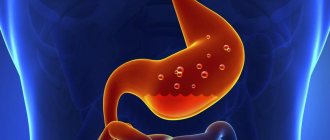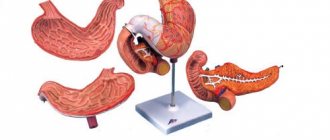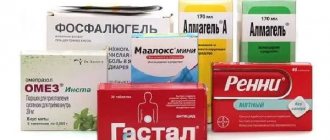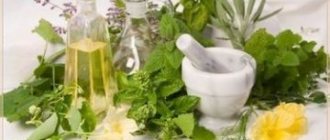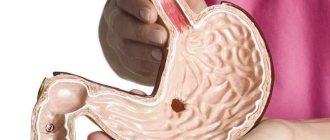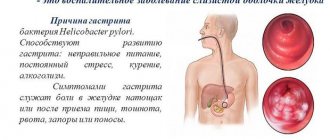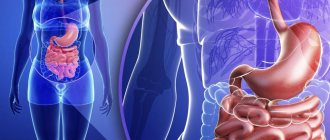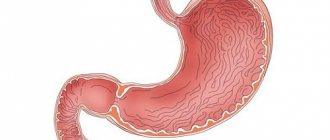Abdominal pain is an accompanying symptom for many diseases. An attack of gastritis begins with severe pain in the stomach area, radiating to the left or right hypochondrium. Painkillers cannot always cope with the problem.
At the initial stage, signs of the disease are almost invisible. A little discomfort in the stomach area is not a reason to go to the doctor. But when severe pain appears, which can last for several hours, the person begins to show anxiety. The disease has already reached a more serious level, and urgent medical intervention is required.
According to the speed of development, gastritis is divided into the following types:
- Acute gastritis is accompanied by pain that occurs as a result of the inflammatory process caused by the ingress of pathogenic microbes or the consumption of alcoholic beverages and coffee. The walls of the stomach are severely damaged and present an open wound.
- Attacks of chronic gastritis also bring pain and discomfort. It is less dangerous, but if left untreated, the consequences can become unpredictable.
Based on the size of mucosal lesions, gastritis is divided into several types:
- Catarrhal gastritis, when the superficial area of the mucous membrane is damaged.
- Erosive, when the inflammatory process goes deep into the muscle layer, and shallow erosions that can be treated form on the walls of the stomach.
- Phlegmonous gastritis, in which the damage to the stomach is very deep, and only medical intervention can save the patient’s life.
What can cause the development of this disease? This is non-compliance with the diet, long pauses between meals, quick meals, lack of liquid and hot lunches.
Provoke the development of gastritis:
- eating foods that irritate the stomach walls (hot and spicy snacks, strong tea and coffee, alcoholic drinks and nicotine);
- misuse of medications;
- disruptions in the immune system and heredity;
- bacterial infection.
Structure and functions of the stomach
The stomach is a hollow muscular organ; its functions include processing the food bolus with acidic gastric juice and moving it further into the duodenum. Pathogenic bacteria die in the stomach, primary protein processing takes place, and some absorption of water and glucose takes place. In addition, stomach cells are involved in the transport of vitamin B12 and secrete a number of digestive hormones.
Structure of the stomach
The mucous membrane of the stomach has a layer of protective mucus that prevents the stomach from “self-digesting.” However, as a result of the aggressive effects of alcohol, the damaging effects of certain types of food and medications, and the action of Helicobacter pylori bacteria, the blood supply to the mucous membrane is disrupted and acid production increases. In this case, an inflammatory process occurs, which leads to the release of biologically active substances into the blood. This signal goes to the central nervous system and a sensation of pain is formed.
What factors provoke an attack?
An attack is a sharp exacerbation of gastritis. Despite the fact that remission can last a long time, depending on the patient’s lifestyle, an attack of gastritis is provoked by many factors:
- Bad habits . For gastritis, it is recommended to completely stop smoking and alcohol-containing drinks. Failure to comply with this rule increases the risk of an attack.
- Deviation from dietary recommendations. Long breaks between meals and unhealthy foods disrupt the integrity of the gastric mucosa and cause re-inflammation.
- Regular stress. Scientists have proven that depression negatively affects the functioning of the stomach.
- Drug therapy without prescription. Some medications negatively affect the functions of the digestive organ.
- Exhausting diets. Insufficient consumption of proteins, carbohydrates and total calories causes exacerbation of gastrointestinal diseases.
What types of gastritis are there?
Highlight:
- Acute gastritis. In this disease, pain occurs due to an intense inflammatory reaction. The cause of acute gastritis is most often the entry of pathogenic bacteria (staphylococcus, salmonella) or aggressive contents (alcohol, chemicals) into the stomach.
- Exacerbation of chronic gastritis. In this case, the intensity and nature of the pain depend on the degree of damage to the mucous membrane (superficial, erosive or atrophic gastritis) and on the localization of the process (antral, fundic or gastritis of the body of the stomach).
How does an attack proceed?
Features of the course of acute gastritis
Acute gastritis always has a clear cause, which led to inflammation of the stomach. Often occurs with high fever and vomiting. Abdominal pain is localized in the epigastric region, cutting in nature. Nausea leads to vomiting of stomach contents, which brings relief. The stool may be normal or one-time liquid.
Advice! These symptoms require emergency medical attention! The emergency doctor will perform a gastric lavage and determine further treatment tactics. In some cases, hospitalization in the infectious diseases department of the hospital is necessary.
Features of the disease in chronic form
An attack during exacerbation of chronic gastritis most often passes without an increase in body temperature. As a rule, exacerbations occur in the autumn and spring, provoked by the consumption of rough, spicy, smoked food or stress.
Pain occurs an hour or two after eating. If the mucous membrane is atrophied, they may occur half an hour later or immediately after eating. With gastroduodenitis, when the stomach and duodenum are affected, pain can occur on an empty stomach and subside when eating.
During an attack of gastritis, pain may be accompanied by nausea and vomiting, after which it becomes easier. When palpating the abdomen in the epigastric region, pain is felt, which intensifies if you tap the anterior abdominal wall in this area with your fingertips.
Acute pain for which medications do not help
If a patient tries to relieve pain during an exacerbation of gastritis at home, but no means help him, he needs to go to the hospital. The clinic will help neutralize an attack of gastritis using drugs and equipment for gastric lavage.
Important! In hospitals, a special probe is used for cleaning, through which a solution is poured into the organ, removing toxins and reducing stomach acidity.
If the pain is moderate, or the patient knows that it is definitely caused by poor-quality food, then they cleanse the body at home. A solution with soda is suitable for this. After washing, they follow a starvation diet for 2 days, in which only tea, water, unsweetened compotes, mineral water, and rosehip infusions are allowed.
Instead of rinsing, use a heating pad with water to relieve pain. It is applied to the stomach area and left until it cools completely.
How to help during an attack?
Porridge for gastritis
Knowing what to do during an attack of gastritis, you can achieve normalization of the condition and prevent the development of complications. Erosive gastritis can lead to bleeding from the gastrointestinal tract, stomach or duodenal ulcers. We talked about the signs of such a serious and very common complication of erosive gastritis as a stomach ulcer in a separate article - Gastric ulcer: causes, classification, symptoms.
Basic recommendations:
- If the disease worsens, you can eat slimy porridges or puree soups, drink alkaline mineral water without gas.
- You can take an antispasmodic tablet, an antacid, or an antisecretory drug from the group of proton pump inhibitors.
- You can make an infusion of mint, chamomile, anise, calendula or St. John's wort. A decoction of flax seeds gives a good effect.
- In the future, you must definitely consult a doctor to undergo an examination, make an accurate diagnosis and complete a full course of treatment.
Advice! For pain associated with stomach diseases, drugs from the group of non-steroidal anti-inflammatory drugs are contraindicated! Such drugs themselves can cause damage to the mucosa and contribute to the development of bleeding from the gastrointestinal tract.
Many people wonder: if a sudden attack of gastritis occurs, what to do, how to relieve the symptoms and how to treat this disease? Gastritis is an inflammatory process of the gastric mucosa. The disease can occur in both acute and chronic forms. First of all, you need to understand what symptoms accompany an acute attack.
Folk remedies
Traditional methods of treatment are time-tested, but before using them, consultation with a specialist is necessary. Here are some of the most common means:
- Herbal infusion. Pour the same amount of dry and crushed plantain leaves, blueberries and St. John's wort into one glass of boiling water and leave for 2 hours. Strain and drink one tablespoon several times a day.
- Flax seeds. Pour one tablespoon of flax seeds with cold water and cook for 3 hours. Cool the broth, strain and drink in small portions throughout the day.
- Sea buckthorn. Pour two tablespoons of fresh or frozen sea buckthorn berries into a glass of boiling water, leave for an hour and drink one tablespoon 3-4 times a day.
- Herbal decoction. Take peppermint, St. John's wort and licorice root in equal quantities. Chop everything, add a glass of water and cook for 15 minutes over low heat. Cool the broth, strain and drink several times a day. If desired, you can add 1-2 teaspoons of honey.
- Mumiyo and propolis. Pour a few tablets of pharmaceutical mumiyo and a small piece of propolis into a glass of boiling water and leave for an hour, drink in small sips throughout the day. To give a more pleasant taste and smell, you can add jam or honey.
- Honey solution. Place one tablespoon of honey in a glass of boiling water. Drink the solution in small sips throughout the day.
Characteristic symptoms
An acute attack of gastritis can be triggered by various reasons, but the most common reason is food. At the initial stage of gastritis, symptoms may appear in the first 5-12 hours.
This form is characterized by the following symptoms.
- an unpleasant and heavy taste appears in the mouth;
- nausea, vomiting, diarrhea, rumbling in the stomach, increased gas formation;
- loss of appetite;
- pain occurs in the epigastric area;
- the temperature may rise slightly;
- The patient develops general severe weakness.
If the cause of gastritis is staphylococcus or salmonella, then the symptoms will be as follows:
- severe diarrhea;
- clear signs of dehydration - the skin and mucous membrane of the oral cavity become dry;
- the amount of urine excreted decreases sharply;
- the temperature rises very strongly - above 39ºC.
If such symptoms occur, the patient must be taken to the hospital very soon, because the sooner help is provided, the less severe the consequences will be.
Phlegmonous gastritis - this dangerous condition is a purulent inflammation of the gastric mucosa. This pathology can develop if a foreign object enters the stomach, causing an inflammatory process.
This attack is accompanied by:
- high temperature;
- severe pain in the left hypochondrium;
- there may be severe vomiting mixed with pus;
- pulse becomes weak;
- the abdomen is sharp on palpation, the tongue is dry, the face is drawn;
- abdominal muscles are very tense;
- if perforation occurs, then there are symptoms characteristic of peritoneal rupture.
Phlegmonous gastritis requires very urgent medical attention.
With erosive gastritis, erosions form on the surface of the mucosa, and the following manifestations may occur:
- pain that gets worse after eating;
- heartburn and nausea occur, which intensifies after eating;
- there may be severe vomiting, while at the beginning of vomiting the stomach cavity is cleared, and only then the vomit consists of gastric juice and bile, there are also blood impurities;
- diarrhea, possibly with bloody discharge.
With chronic gastritis, pain usually occurs 2 hours after eating. In the atrophic form of the disease, pain may begin immediately after eating. If the duodenum is affected simultaneously with gastric damage, pain occurs if the stomach is empty, and after eating it decreases. With exacerbation of chronic gastritis, vomiting is observed, after which the patient noticeably feels better. When palpating the epigastric region, the patient experiences pain.
How to relieve an attack?
The signs of gastritis are quite easy to differentiate if you carefully read the symptoms described above. There is no point in leading to complications or waiting for the pain to go away on its own. We must try to eat right and avoid drinking alcoholic beverages. Proper nutrition is not only food that contains high-quality and healthy products, it is also a diet. You need to eat at a certain time, take your food slowly and chew it thoroughly.
Treatment of gastritis should be carried out under the supervision of a doctor; it is better not to resort to self-medication, because the pathology can progress and enter an advanced stage. Only a specialist can prescribe the necessary medications to a patient based on the form and cause of the disease, the general condition of the patient, his age, weight and the presence or absence of other gastrointestinal diseases. Having received the doctor’s recommendations, the patient can not only stop the attacks on his own, but also get rid of this disease.
If gastritis makes itself felt at night or at a time when doctor’s help is impossible, then you can use either medications prescribed by a doctor, or use harmless traditional medicine - chew licorice root, drink mint tea or potato juice.
Almost always, the culprit of gastritis is a pathological bacterium; you can get rid of it with the help of antibacterial agents; at the same time, the patient is prescribed medications containing bismuth salts - it is needed for the gastric mucosa to heal. The patient is also recommended to take medications that relieve spasms, non-steroidal anti-inflammatory drugs - Ketoprofen, Indomethacin, Aspirin. However, you should not get carried away with these drugs; they all irritate the gastric mucosa. If, with chronic gastritis, attacks occur quite often, then treatment is best carried out in specialized sanatoriums with mineral water sources.
